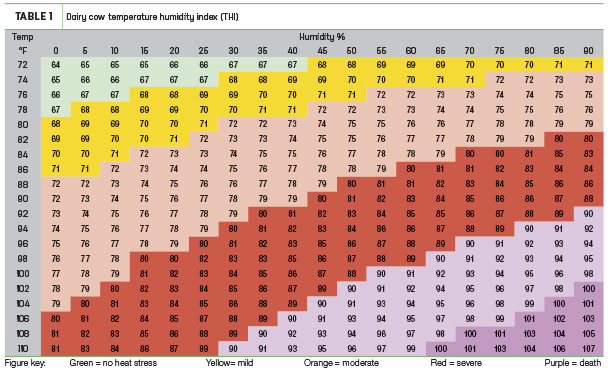It is well documented that summer heat can have both short-term and long-term impacts on the production potential of dairy cows.
The normal temperature of the dairy cow is 101.5ºF. When outside temperatures exceed 77ºF, or when the temperature-humidity index (THI) exceeds 72ºF, cows begin exhibiting signs of heat stress (Table 1).
Indicators to watch for when cows are suffering the effects of hot, humid weather include:
- Body temperature exceeding 102.6ºF
- Panting in excess of 80 breaths per minute
- Reduced activity
- Feed intake reduced by more than 10%
- Milk yield reduced by more than 10%

Reduced dry matter intake (DMI) is often the first visual sign of heat stress, as cows generally eat less as a protective mechanism to reduce metabolic heat production. Several factors can influence the extent of heat stress for cows. Those factors, which can influence metabolic heat production, heat dissipation and, ultimately, the potential degree of stress, include:
- The severity of the environmental conditions
- Milk yield and the quantity of feed consumed
- The stage of lactation
- The size of the cow
- Cooling management
- Exercise requirements
- Breed and color
To prevent any of the symptoms above from occurring, it is important to re-evaluate the heat stress mitigation protocols and the ration in place in order to minimize the immediate and long-term implications of heat stress. The implementation of fundamental cooling practices/systems is crucial to minimize losses in DMI. These fundamentals include shade, fans and sprinklers and will typically offer the greatest return on investment when it comes to minimizing heat stress.
University research has shown that properly cooling cows can improve DMI by 7% to 9% and milk yield by 8.6% to 15.8%, compared to cows without cooling systems in place experiencing the same environmental conditions.
Once cooling systems are in place, it is time to re-balance the ration based on the current DMI. Energy intake is directly related to DMI, and practical approaches to maintaining DMI include more frequent feeding, the use of high-quality forages, proper nutrient balance and greater nutrient density. Ration nutrient density must increase in periods of lower intake to deliver sufficient nutrients to the cow. Additionally, changes in eating patterns generally occur during hot weather, with cows eating more of their meals during the coolest parts of the day.
Another area to focus on is water availability and water trough cleanliness. As the environmental temperature increases from 40ºF to 80ºF, water consumption of dry cows increases by up to 33%. In lactating cows, water consumption during the same change in temperature increases sharply, by approximately 70%. Increased water intake is necessary in warmer weather due to sweating and more rapid respiration rates, both of which help to increase evaporative cooling for the cow. Algae growth will increase in the summer months; therefore routine daily cleaning of water troughs is recommended. It is also important to maintain approximately 4 linear inches of clean water space per cow to ensure adequate water availability. One easy way to help promote water intake in the summer months is to provide access to water at the milking parlor exit.
In the summer, many factors can result in higher locomotion scores, including increased perching, increased humidity, increased moisture on the walking surface due to increased urination and sprinklers and, in general, more time standing. Enhanced protocols that can help mitigate poor locomotion include more frequent footbaths, increased manure management and supplementing feed additives such as zinc and biotin for improved hoof health.
Nutritional considerations
Forages
Strive to incorporate your highest-quality forages in the summertime, when intakes may be your limiting factor for milk production. Doing so will enhance nutrient density and digestibility while helping to reduce heat from fermentation within the rumen and will ultimately allow for maximized production potential.
Nutrient density
Consider increasing the energy density of the ration to maintain the energy requirements and body condition of the cow, but keep in mind that energy-dense ingredients, such as concentrates, can have a negative effect on rumen stability. Increasing dietary protein levels, especially rumen-undegradable protein, can help the cow achieve her optimal protein status. Adding additional minerals, such as potassium and sodium bicarb, can help achieve a more positive DCAD, thus creating a friendlier rumen environment during the summer months. Adding free-choice salt and sodium bicarb in the summer has also led to encouraging results in lactating cow performance. Maintaining adequate physically effective fiber within rations that are more energy-dense is crucial to preserve milkfat production in warmer months.
Rumen-inert fat
Incorporating rumen-inert fat into lactating cow rations during summer heat can be a huge help in achieving increased energy intake during periods of lower DMI. There are several options to consider when selecting a bypass fat supplement. It is important to evaluate the fat source based on the cost per unit of total fatty acids delivered. In the summertime, this tends to favor a high-stearic fat (C18:0) blend, which can help maintain body condition scores while also helping to preserve reproductive performance.
Rumen health additives
If they are not already included, the inclusion of yeast, direct-fed microbials and mycotoxin binders can help to quickly increase the feed efficiency of the animal by maximizing the efficacy of rumen microbes. An efficient rumen leads to a profitable cow.
Working with your nutritionist is key to maximizing your herd’s profitability into the summer months. Stay in the driver’s seat and evaluate your ration, management.
References omitted but are available upon request by sending an email to the editor.









